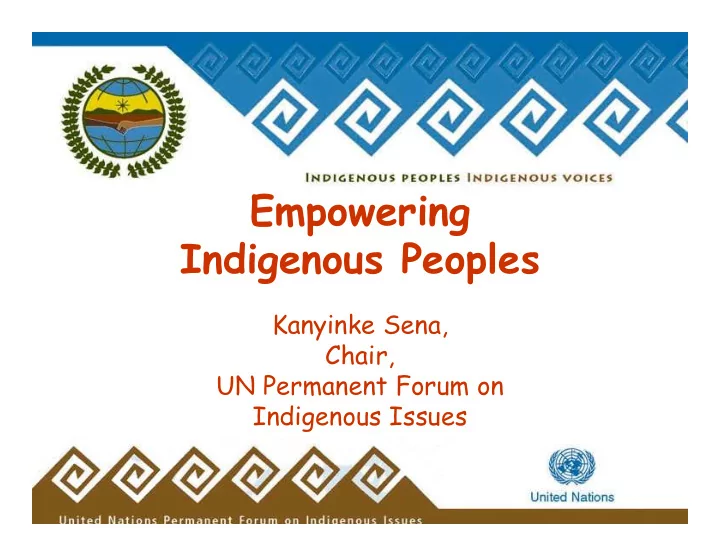

Empowering Indigenous Peoples Kanyinke Sena, Chair, UN Permanent Forum on Indigenous Issues 1
Outline • Disempowering Indigenous Peoples; • UN Declaration as a basis for empowering Indigenous Peoples; • Indigenous Peoples and Decent work; • Policies shift; • Strategies for empowering indigenous peoples. 2
Disempowering Indigenous Peoples Indigenous peoples: • 370 million in some 70 countries (UNFPA). • 5% of the world’s population, • 5% of the world’s poor (IFAD). Concepts: terra nullius - public domain - national interests promote dispossession of lands, territories and knowledge systems. 3
UN Declaration as a basis for empowering Indigenous Peoples • UNDRIP framework for empowering Indigenous Peoples. • UNDRIP does not confer new rights. • UNDRIP affirms the social, political, economic, cultural and political rights recognized by other international instruments. • Indigenous Peoples’ rights are NOT special rights 4
Indigenous Peoples and Decent work • NO specific policy document • ILO Convention No. 169 overcomes discrimination of indigenous peoples but NOT indigenous peoples in the work place. • ILO 169 is one of the least ratified conventions, with only 22 ratifications to date. – Majority: Latin American countries. – Asia: Nepal and Fiji – Africa: Central African Republic 5
Policies shift • Recognition " how do you empower that which you do not recognize "? • Two-way capacity building • Development of Indigenous Peoples by states and UN agencies : – UNDRIP, – UNDG Guidelines on Indigenous Issues, – IASG – Other UN agencies are yet to develop policies. 6
Strategies for empowering indigenous peoples • Development of a collective, shared vision. • Accelerated recognition of rights will reduce marginalization. • Provision of quality education to indigenous children. • Partnerships for development . • Indigenous Peoples entrepreneurship programs . 7
continuation… • Mechanisms for the full and effective participation of indigenous peoples. • Good governance . • New forms technology and social media . 8
Thank you kanyinke@gmail.com 9
Recommend
More recommend